Understanding the Complex Relationship Between Screen Time and Autism
In today's digital age, children are exposed to screen media from a young age, making it critical to understand how this exposure impacts developmental conditions such as autism spectrum disorder (ASD). Emerging research shows a nuanced relationship between screen time and the progression or mitigation of autism symptoms, highlighting both risks and potential intervention strategies. This article explores the role of screen time in autism, the benefits of behavioral analysis therapy, and practical approaches for families and professionals to improve outcomes for children with ASD.
What is Behavioral Analysis Therapy for Autism?

What is behavioral analysis therapy for autism?
Behavioral analysis therapy for autism, often referred to as Applied Behavior Analysis (ABA), is a scientific and evidence-based method. It focuses on improving social, communication, and adaptive skills in individuals diagnosed with autism spectrum disorder (ASD). Using principles of learning and behavior, ABA seeks to increase positive behaviors and decrease those that may be harmful or interfere with functioning.
Core principles of ABA
ABA relies heavily on the ABC model – which stands for Antecedent, Behavior, and Consequence – to assess and understand behaviors in context. This framework helps identify what triggers a behavior, the behavior itself, and the outcome that either reinforces or discourages it. Central strategies include positive reinforcement to encourage desired actions, task analysis to break down complex skills into manageable steps, and naturalistic teaching methods that incorporate learning into everyday activities.
Assessment frameworks like ABC model
In practice, ABA practitioners use structured assessments based on the ABC model to develop personalized intervention plans. These assessments evaluate behaviors, environmental factors, and functional communication skills. Understanding the antecedents and consequences of behaviors allows therapists to design effective strategies targeting specific needs of each individual.
Intervention strategies
Typical ABA intervention techniques include discrete trial training (structured teaching sessions), pivotal response treatment (focus on motivation and responsiveness), and modeling desired behaviors. Interventions often emphasize skill-building in communication, social interaction, and self-care.
Settings and intensity
ABA therapy can take place across multiple settings, such as the home, school, or clinic. It is generally delivered with high intensity, often several hours per week, especially during early childhood, which has been shown to produce better developmental outcomes.
Evidence base and contemporary practice
A robust body of research supports ABA’s effectiveness, particularly for enhancing cognitive, language, and social skills when started early. Contemporary practice stresses ethical considerations, individualized goals, and family involvement. Despite proven benefits, some debate exists regarding therapy approaches, with advocates emphasizing respect, autonomy, and neurodiversity perspectives.
How Behavioral Analysis Therapy Supports Individuals with Autism
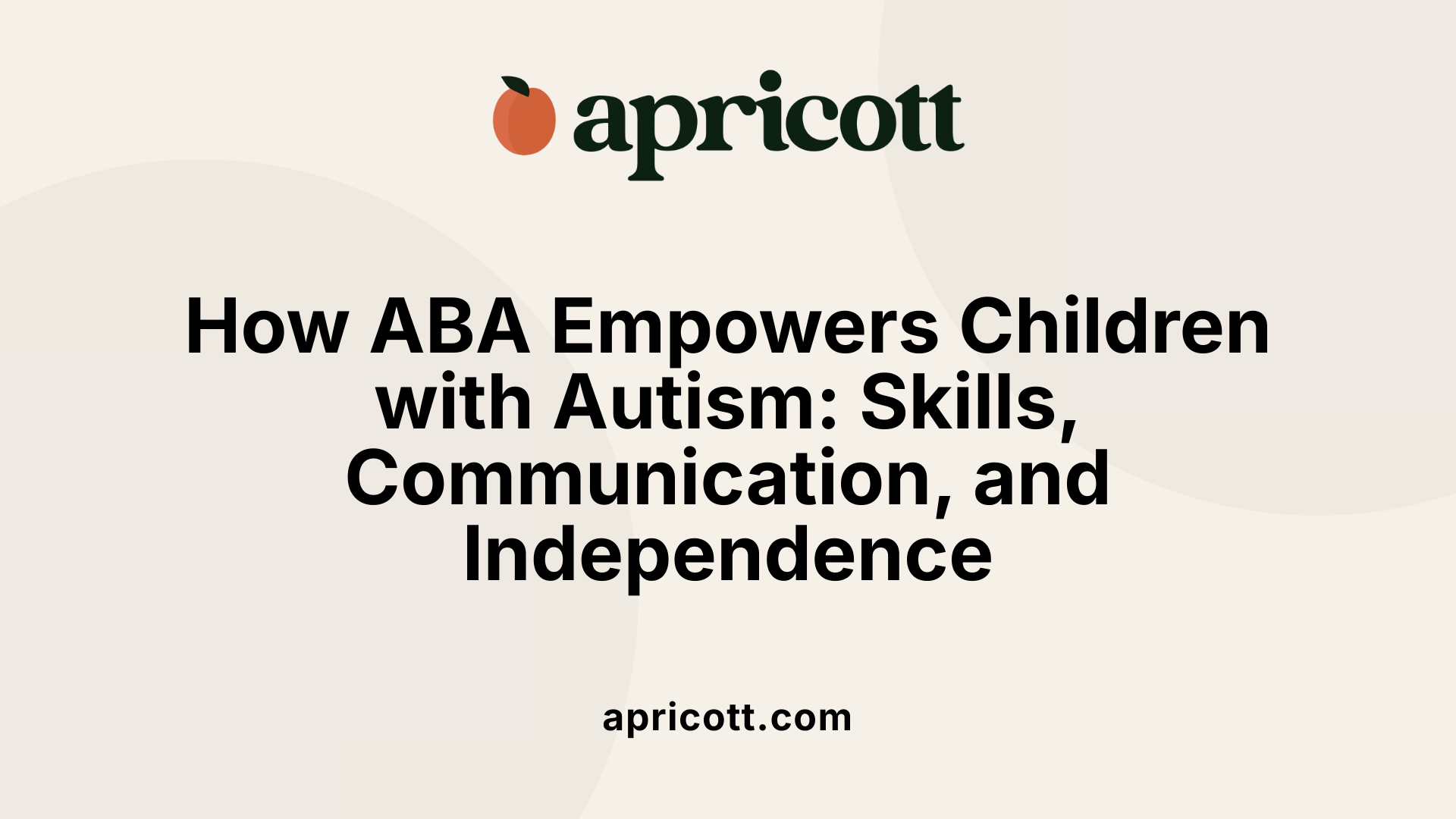
How does behavioral analysis therapy help individuals with autism?
Behavioral analysis therapy, commonly known as ABA (Applied Behavior Analysis), is a structured and evidence-based approach designed to support individuals with autism. This therapy focuses on teaching new skills and decreasing challenging behaviors by emphasizing the relationship between behavior and the environment.
Structured teaching and individualized programs
ABA uses carefully designed, individualized programs tailored to each child's unique needs. These programs break down complex skills into smaller, manageable parts, enabling children to learn systematically. Through structured teaching, therapists create predictable environments that help children understand expectations and enhance learning efficiency.
Positive reinforcement and skill development
Central to ABA is the use of positive reinforcement. When a child exhibits a desired behavior, they receive immediate and meaningful rewards, encouraging repetition of that behavior. This helps improve communication, social interaction, and daily living skills, which are essential for personal and academic growth.
Improvements in communication and social skills
With consistent ABA intervention, children demonstrate significant gains in language, eye contact, peer engagement, and social responsiveness. These improvements empower children to interact more effectively with family members, teachers, and peers, enhancing their overall quality of life.
Long-term benefits and empowerment through therapy
Early and intensive ABA therapy leads to long-lasting benefits. Scientific studies support ABA’s effectiveness in fostering independence and emotional well-being. By learning practical skills and managing behaviors, individuals with autism gain confidence and greater involvement in their communities, contributing to a more fulfilling life journey.
Who Provides Behavioral Analysis Therapy for Autism?

Who provides behavioral analysis therapy for autism?
Behavioral analysis therapy for autism, commonly known as Applied Behavior Analysis (ABA), is provided by professionals trained specifically in this field. The main providers are Board Certified Behavior Analysts (BCBAs) and licensed therapists who specialize in autism spectrum disorder (ASD).
What roles do BCBAs and licensed therapists play?
BCBAs lead the development of individualized treatment plans grounded in detailed assessments of a child's abilities, needs, and family priorities. Licensed therapists implement these plans using evidence-based strategies such as positive reinforcement and detailed behavior analysis to promote skills like communication, social interaction, and daily living, while also working to reduce challenging behaviors.
How are ABA programs developed?
Programs are carefully crafted after comprehensive assessments that evaluate a child's current functioning and family goals. These treatment plans are personalized and evolve over time to meet the child's progress and changing needs.
How accessible is behavioral analysis therapy?
Accessing ABA often involves multiple steps: consulting healthcare providers, obtaining diagnostic evaluations, and verifying insurance coverage. Due to increasing recognition of ABA's effectiveness, many insurance plans, including Medicaid, now cover these services. However, availability may vary based on location and provider networks.
Where is behavioral analysis therapy provided?
Therapy is delivered in diverse settings such as homes, clinics, schools, and community environments to allow for naturalistic learning and skill generalization. This flexibility helps tailor interventions to each child's unique context and support system.
These professional services form the cornerstone of effective autism treatment, providing children and families with targeted support that fosters development and independence.
Common Techniques Used in Behavioral Analysis Therapy for Autism

What are the common techniques used in behavioral analysis therapy for autism?
Behavioral analysis therapy, often referred to as Applied Behavior Analysis (ABA), employs several structured techniques to foster learning and development in children with autism spectrum disorder (ASD). These methods focus on enhancing communication, social skills, and adaptive behaviors, while reducing challenging behaviors.
Discrete Trial Training (DTT) is a highly structured approach involving a clear beginning, prompt, response, and reinforcement. It breaks down skills into small, teachable units practiced repeatedly, helping children master specific tasks through consistent prompting and rewards.
Natural Environment Teaching (NET) contrasts with DTT by embedding learning opportunities naturally within daily routines and activities. This encourages generalization of skills across settings, increasing their functional use.
Modeling and reinforcement are integral techniques where therapists demonstrate desired behaviors for children to imitate. Positive reinforcement—including praise, tokens, or preferred activities—strengthens these behaviors, making them more likely to occur.
Prompting and fading guide children toward independence by initially providing assistance and then gradually reducing it as the child learns the skill.
To support communication, tools like the Picture Exchange Communication System (PECS) give children a way to express needs and thoughts through images, fostering effective interaction.
For complex behaviors, behavior chaining teaches sequences of actions in steps, while script fading moves children from memorized dialogues to spontaneous conversation, promoting social communication.
Together, these techniques form a comprehensive, individualized system based on behavioral science, often implemented by trained professionals to meet each child's unique needs and support developmental progress.
The Impact of Excessive Early-Life Screen Time on Autism Symptoms
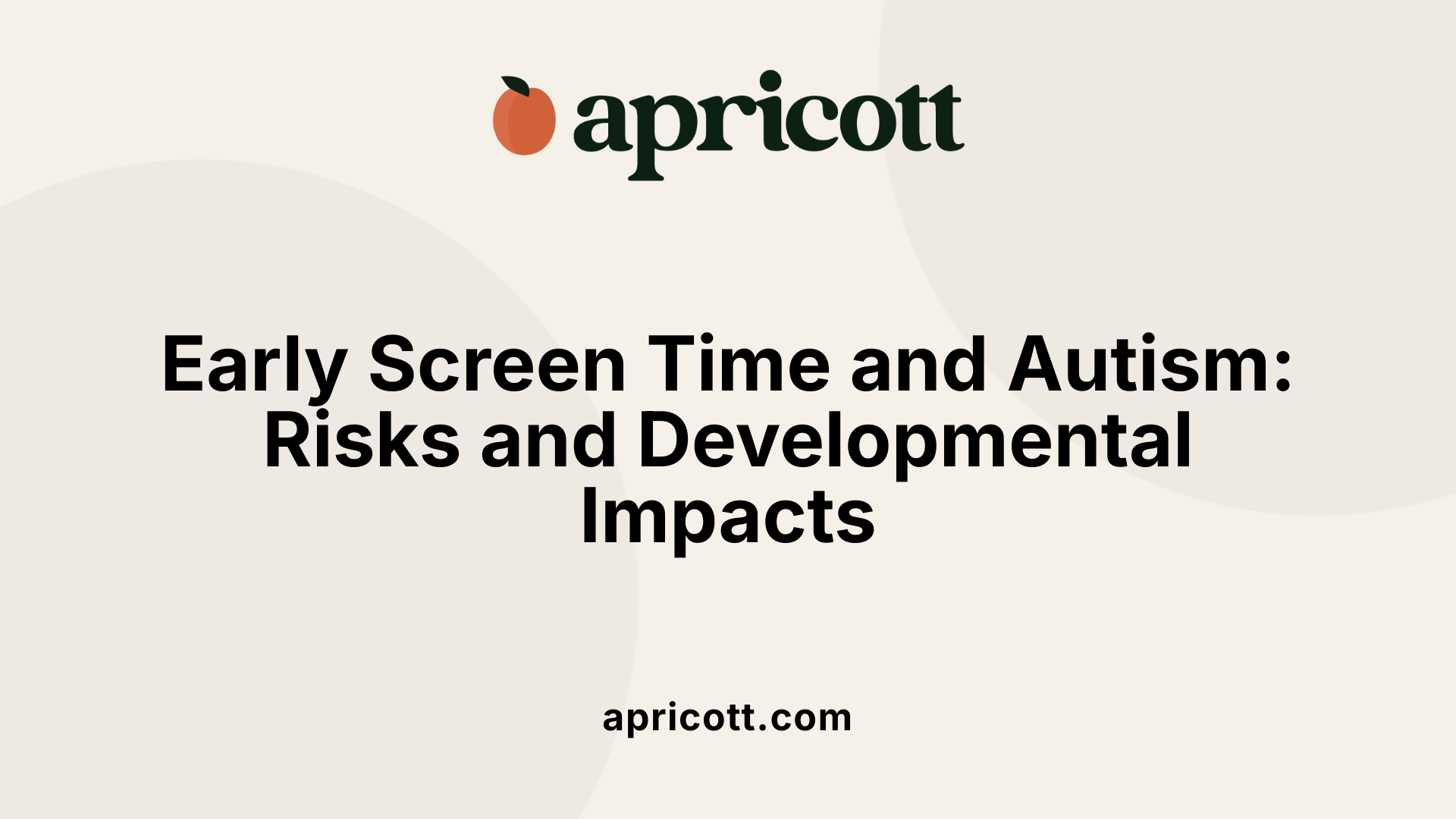
How does high screen time in early life associate with developmental delays and autism symptoms?
Children exposed to excessive screen time at an early age often experience developmental delays and aggravated autism symptoms, especially those already diagnosed with ASD. Studies reveal that newborns and toddlers watching screens for more than four hours daily show increased risks of developing autism-like symptoms, with notable impacts on language, social skills, and behavioral functioning.
What is the relationship between screen time and autism symptom severity?
Screen time duration positively correlates with autistic symptom severity. For example, higher daily screen exposure often aligns with higher scores on autism severity scales such as the Childhood Autism Rating Scale (CARS). Conversely, reductions in screen time have led to marked improvements including improved eye contact, vocabulary expansion, and social engagement.
Does early screen exposure affect the risk of a later autism diagnosis?
Yes, high screen exposure in early childhood is linked to greater risks of later autism diagnoses. Children with prolonged screen time show lower developmental scores and increased symptom severity, emphasizing the potential benefits of early screening reduction to improve developmental trajectories.
How does screen time impact brain development and mental health in children with ASD?
Increased screen time correlates with higher anxiety and depression levels. Brain imaging studies indicate reduced cortical volume in the left superior frontal region among children with more screen exposure. This smaller brain region volume mediates the relationship between screen time and elevated anxiety/depression symptoms, highlighting a neurological basis for the mental health challenges associated with excessive screen use.
What are the current screen time statistics among children with ASD?
Children with ASD often exceed recommended screen time standards; for example, Chinese children with ASD average 2.64 hours daily, frequently using multiple devices. Most screen activities involve watching cartoons and nursery rhymes, with limited parental co-viewing. Approximately half avoid screen use before sleep, though many still use devices pre-bedtime, potentially affecting sleep quality and overall development.
| Topic | Findings | Additional Details |
|---|---|---|
| Developmental delays | Linked to >4 hours daily screen time | Reported in multiple case studies and national data sets |
| Autism symptom severity | Positively correlated with screen exposure and CARS scores | Reduced with lowered screen time |
| Risk of later diagnosis | Higher with prolonged early screen time | Screen time >1 hour daily linked to worse outcomes |
| Brain development and mental health | Reduced cortical volume in left superior frontal area mediates anxiety/depression related to screen use | MRI studies confirm anatomical changes |
| Screen time statistics | Avg. 2.64 hours daily among ASD children in China; multiple devices common | Limited parental involvement during screen use |
Screen Time and Its Influence on Social and Language Development in ASD
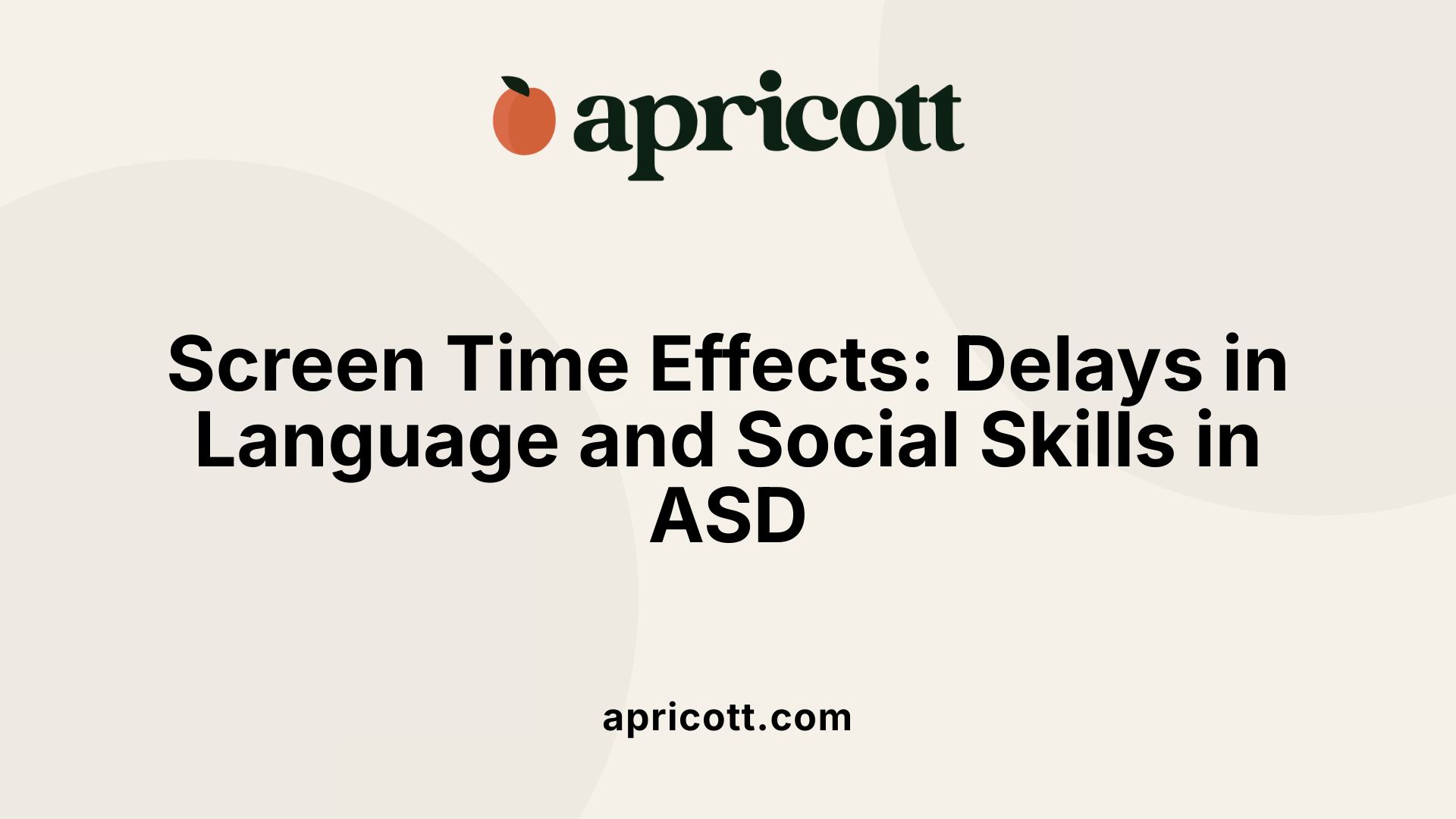
How Does Excessive Screen Time Negatively Affect Language Growth in Children with ASD?
Research has consistently shown that high screen exposure in early childhood is linked to delays in language development among children with Autism Spectrum Disorder (ASD). Excessive screen time interrupts crucial early-life opportunities for social interaction and language learning, leading to poorer performance on language development scales. For example, children exposed to more than four hours of daily screen time at 12 months have demonstrated higher risks of developing autism-like symptoms and delayed vocabulary growth.
In What Ways Does Screen Time Reduce Parent-Child Interaction?
Screen usage often occurs without active parental involvement; studies indicate only about 34% of children with ASD engage in screen time alongside parental communication. This lack of co-viewing dramatically cuts down meaningful parent-child interactions, which are essential for social and language development. Reduced interaction correlates with worsened autism outcomes and lower developmental scores, as these interactions cultivate critical communication and social skills.
What Is the Correlation Between Screen Time and Behavioral Issues in ASD?
Increased screen exposure correlates strongly with behavioral challenges, including heightened repetitive behaviors and social withdrawal. Studies report that children in high screen time groups score higher on anxiety and depression scales and exhibit more severe core autism symptoms compared to those with limited screen use. The negative behavioral effects often coincide with neuroanatomical changes, such as reduced cortical volume in brain areas linked to emotion regulation and social cognition.
What Does Case Study Evidence Suggest About Social and Language Improvements After Reducing Screen Time?
Compelling case reports have documented marked improvements in social engagement and language skills following a significant reduction in screen exposure. For instance, one child displayed enhanced eye contact, expanded vocabulary, and increased peer interaction, leading to the disappearance of ASD signs by age 8. Another case noted that repetitive behaviors fluctuated in tandem with screen time changes—improving with less screen exposure and worsening when screen time increased. These findings underscore the potential for targeted interventions focused on replacing screen use with socially oriented activities to foster developmental progress.
| Aspect | Effect of Excessive Screen Time | Improvement Post Screen Reduction |
|---|---|---|
| Language Development | Delayed vocabulary growth and poorer language scores | Vocabulary expansion and improved communication |
| Parent-Child Interaction | Reduced co-viewing and communication opportunities | Increased engagement and interaction |
| Behavioral Symptoms | Increased repetitive behaviors and anxiety/depression | Decrease in repetitive behaviors and anxiety |
| Social Skills | Withdrawal and reduced peer engagement | Enhanced eye contact, social interaction, and peer play |
Case Studies Highlighting the Effects of Screen Time Reduction
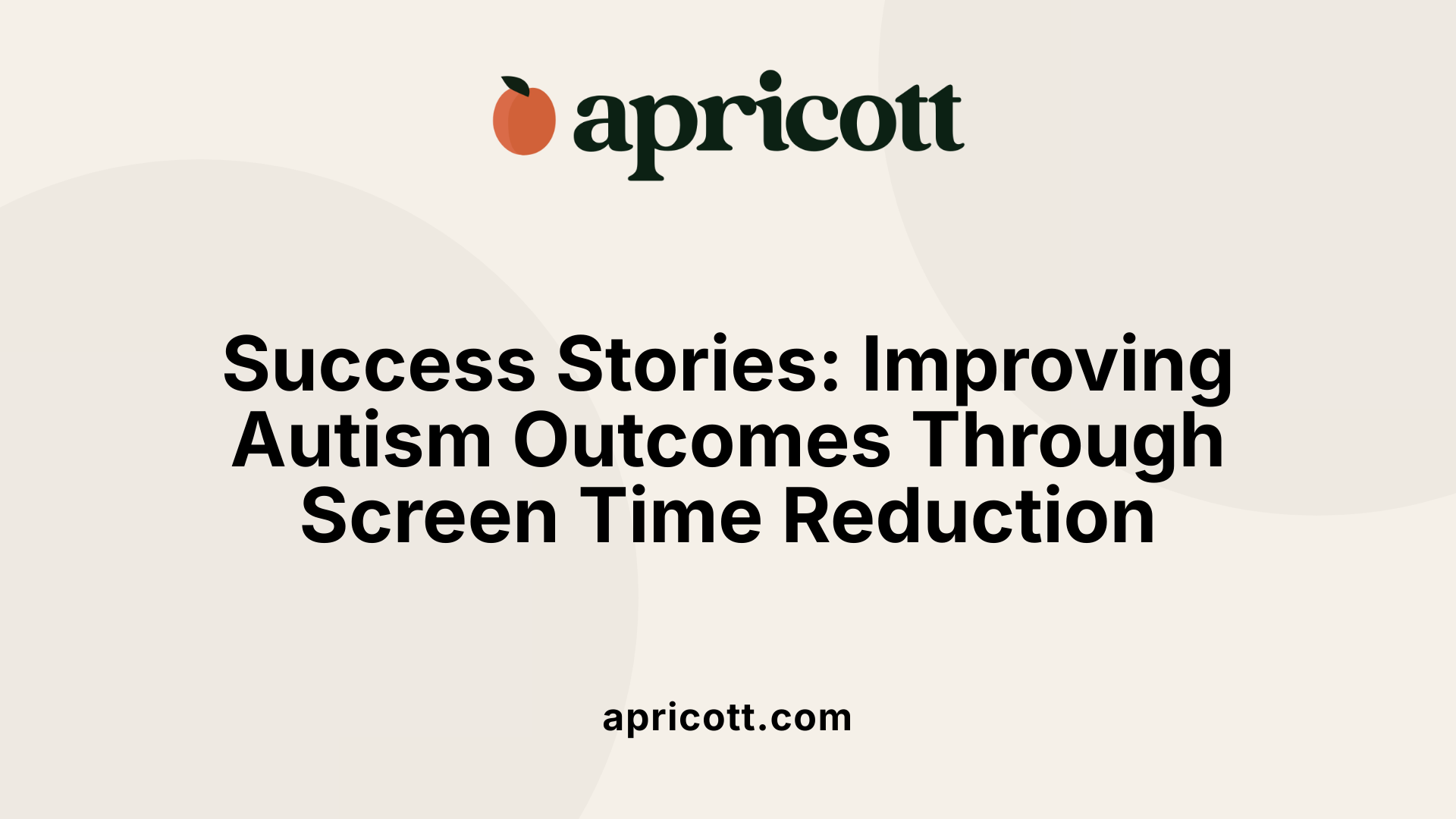
Examples of Improved Eye Contact and Vocabulary
One notable case illustrated significant developmental gains following a decrease in screen time. The child showed enhanced eye contact—a crucial social skill often impaired in ASD—as well as noticeable vocabulary growth. Increased engagement with peers also became evident. These changes culminated in the child no longer exhibiting ASD signs by age eight, suggesting how reduced screen exposure can support language and social milestones.
Reduction of Repetitive Behaviors
Another detailed case tracked repetitive behaviors, a hallmark of autism, in relation to screen use. When screen time was increased, these behaviors worsened noticeably. Conversely, reducing screen exposure correlated with marked improvement, emphasizing the direct behavioral impact that screen time fluctuations can have on children with ASD.
Cases of ASD Symptom Resolution with Screen Time Decrease
Beyond isolated improvements, reports have documented complete resolution of autism symptoms following substantial screen time reduction. Such cases indicate the potential power of early intervention focused on limiting media exposure, combined with social and therapeutic activities, to alter developmental trajectories.
Correlation Between Screen Time Fluctuations and Symptom Changes
General trends in the case studies reveal a clear pattern: increases in screen exposure are linked with symptom deterioration, including social withdrawal and language stagnation. In contrast, decreased screen time aligns with improvements in social interaction, language development, and behavioral regulation. These correlations underscore the importance of mindful management of screen use for children diagnosed with ASD.
Interventions Combining Screen Time Reduction with Social Engagement

Parent Training Programs
Effective interventions often include parent training programs designed to drastically reduce children's screen time while enhancing social interaction. A notable pilot program successfully reduced daily screen exposure from about 5.6 hours to merely five minutes. This intervention was linked to a 23% decrease in core autism symptoms and a 37% reduction in parental stress, highlighting the dual benefits for both children and caregivers.
Replacement of Screen Time with Social Activities
Replacing screen time with socially oriented activities has shown promising outcomes in children with ASD. Such interventions encourage parent-child interactions and peer engagement, fostering improvements in communication and social behaviors. For instance, case studies report enhanced eye contact, vocabulary growth, and peer interactions following reductions in screen exposure.
Measurable Improvements in Autism Symptoms
Significant improvements in autism-related symptoms have been documented post-intervention, including reductions in repetitive behaviors and better adaptive functioning. These enhancements underscore the potential of combined screen time reduction and social engagement to positively modify developmental trajectories in ASD.
Impact on Parental Stress
Beyond child-focused benefits, parents also experience decreased stress after participating in screen reduction programs. Enhanced family interaction and perceived progress in their child's development contribute to improved parental well-being.
Importance of Family Involvement
Despite high screen exposure among children with ASD, parental involvement during screen time is often limited. Interventions that involve parent education and in-home support have proven effective in facilitating meaningful reductions in screen usage. Encouraging active family participation not only curbs screen time but also promotes more enriching social experiences for the child.
These combined intervention approaches suggest that strategically reducing screen exposure while promoting social engagement can substantially benefit children with ASD and their families.
American Academy of Pediatrics Guidelines on Screen Time for Young Children
What are the recommendations for screen exposure under 18 months?
The American Academy of Pediatrics (AAP) recommends minimal to no screen media exposure for children younger than 18 months. This guidance stems from evidence suggesting that early excessive screen time is linked to developmental delays and increased autism-like symptoms in young children. The recommendation encourages parents to avoid introducing screen devices as a primary form of stimulation during this critical period of brain development.
What is the limit for co-viewing through age 5?
For children aged 18 months to 5 years, the AAP suggests limiting screen time to no more than one hour per day of high-quality programming. Crucially, the AAP emphasizes "co-viewing" or shared screen time, where parents and children watch together. This practice enhances understanding, allows for discussion, and helps contextualize content, making screen time more socially interactive and less isolating.
What is the rationale behind the guidelines?
The rationale centers on the potential harms of excessive screen time on young children’s social, language, and behavioral development. Research highlights links between high screen exposure and worsened autism symptoms, reduced language acquisition, and poorer parent-child interaction. Limiting screen time supports healthier developmental trajectories by encouraging active learning through social engagement rather than passive media consumption.
Why is parent-child interaction during screen time important?
Parental involvement during screen viewing boosts the developmental benefits of screen media by turning passive consumption into interactive experiences. When caregivers engage with children during screen time, they promote vocabulary building, emotional connection, and understanding of social cues. The AAP’s guidelines thus highlight co-viewing as a tool to enhance the quality of screen exposure, counteracting some negative effects associated with screens used in isolation.
Overall, these guidelines aim to reduce harmful effects linked to early-life screen time and promote environments rich in social and developmental interaction for young children.
Risk Factors Contributing to High Screen Exposure in Children with ASD
What factors contribute to elevated screen time in children with ASD?
Several interconnected factors contribute to increased screen exposure among children with Autism Spectrum Disorder (ASD). Understanding these can help families and professionals tailor interventions to reduce screen time effectively.
Low paternal education: Children with fathers who have lower educational attainment are more likely to experience longer daily screen time. This may relate to less awareness or resources regarding healthy media use.
Lack of parental restrictions: Parents who do not set clear limits on screen use tend to have children with higher screen exposure. Without defined boundaries, screen time can escalate unconsciously.
Greater caregiver screen time: Caregivers' own screen habits influence children’s screen use. Higher adult screen engagement often models increased device usage, contributing to more child screen exposure.
Use of screens as childcare tools: Many families rely on electronic devices to occupy children, especially as behavioral management tools. While practical short-term, this approach can lead to prolonged screen time.
Ownership of independent electronic devices: Nearly half of children with ASD use two or more types of devices daily, such as tablets and smartphones. Access to multiple devices increases opportunities for extended screen exposure.
Together, these factors create an environment where excessive screen time becomes likely, negatively impacting developmental outcomes. Targeting these risk factors through parent education and structured family routines represents a promising path to reducing screen exposure and enhancing social engagement for children with ASD.
Correlations Between Screen Time, Anxiety, and Brain Structure in ASD
How Does High Screen Exposure Affect Anxiety and Depression in Children with ASD?
Children with autism spectrum disorder (ASD) who experience high-dose screen exposure show significantly increased anxiety and depression symptoms. Studies using the Child Behavior Checklist (CBCL) revealed that children with high screen time (HDE group) had an average anxiety/depression score of 60.02, compared to 50.17 in the low-dose exposure (LDE) group. This positive correlation (r = 0.20) indicates that more screen time is linked to elevated mental health issues in these children.
What Is the Link Between Screen Time and Cortical Volume in the Brain?
Research found that high screen exposure is associated with reductions in cortical volume, specifically in the left superior frontal area of the brain. Children in the HDE group had a mean cortical volume of 25,232.13 mm³ in this region, whereas the LDE group showed a mean volume of 26,441.19 mm³, illustrating a significant negative correlation (r = -0.29). This reduction may contribute to the severity of anxiety and depression symptoms observed.
What Does Mediation Analysis Reveal About Brain Changes and Mental Health?
Mediation analysis demonstrated that the cortical volume of the left superior frontal area fully mediates the relationship between screen time and anxiety/depression symptoms. This suggests that brain structural changes in this region serve as a critical mechanism by which increased screen exposure leads to worsened mental health outcomes in children with ASD.
How Do Regression Analyses Support These Findings?
Even after controlling for potential confounders such as ASD severity, age, and family income, regression analysis confirmed that screen time remains a significant predictor of anxiety and depression symptoms. This underscores the independent impact of screen exposure on mental health beyond other clinical or demographic factors.
Implications for Therapy: Integrating Screen Time Management into ABA Programs
What therapeutic challenges arise with high screen exposure in children with ASD?
High screen exposure in children with ASD poses significant challenges for therapy. Research shows a strong link between excessive screen time and worsened autism symptoms, including social, language, and behavioral difficulties. Children with more than 2 hours of daily screen time often exhibit poorer responses to therapy, increased repetitive behaviors, and elevated anxiety and depression levels. Screen time also correlates with reduced parent-child interaction, which is essential for behavioral growth. Moreover, brain imaging studies reveal that extensive screen use is associated with decreased cortical volume in areas critical for executive function, further complicating therapeutic progress.
How can reducing screen time enhance response to behavioral interventions?
Lowering screen exposure has been tied to remarkable improvements in treatment outcomes for children with ASD. Case studies highlight reductions in screen time leading to enhanced eye contact, vocabulary expansion, and more active peer engagement. Notably, some children showed such progress that core autism symptoms diminished or resolved entirely. Interventions replacing screen time with socially oriented activities yielded declines in repetitive behaviors and improved adaptive functioning. Additionally, parental stress decreased significantly when screen time was minimized, suggesting a positive ripple effect on the therapy environment.
What strategies are effective for incorporating social activities instead of screen time?
Successful strategies emphasize structured replacement of screen activities with interactive social engagement. Parent-mediated programs focus on increasing joint attention, shared play, and communication during daily routines. Using parent education combined with weekly in-home support visits has proven effective, reducing screen time from hours to minutes daily. The programs encourage activities such as reading together, playing cooperative games, and encouraging peer interactions. Consistent monitoring and gradual shifting away from passive screen consumption to active social contexts are vital to sustaining progress.
How can therapists collaborate with families to monitor and manage screen use?
Therapeutic success depends on an alliance with families to monitor and control screen exposure. Clinicians should assess baseline screen habits and educate parents about the impact of excessive screen time on ASD symptoms and development. Providing tailored guidelines aligned with American Academy of Pediatrics recommendations helps set achievable goals. Collaborative goal-setting includes instructions on limiting screen time, encouraging co-viewing and interaction, and integrating alternative social activities. Routine follow-ups and support foster parental confidence in enforcing screen limits while nurturing rich, developmentally supportive interactions at home.
Integrating screen time management into ABA programs can therefore enhance treatment responsiveness in children with ASD. Balanced approaches that reduce passive screen exposure while promoting meaningful social engagement hold promise for improving developmental trajectories and reducing symptom severity.
Recommendations for Parents and Caregivers to Optimize Development in Children with ASD
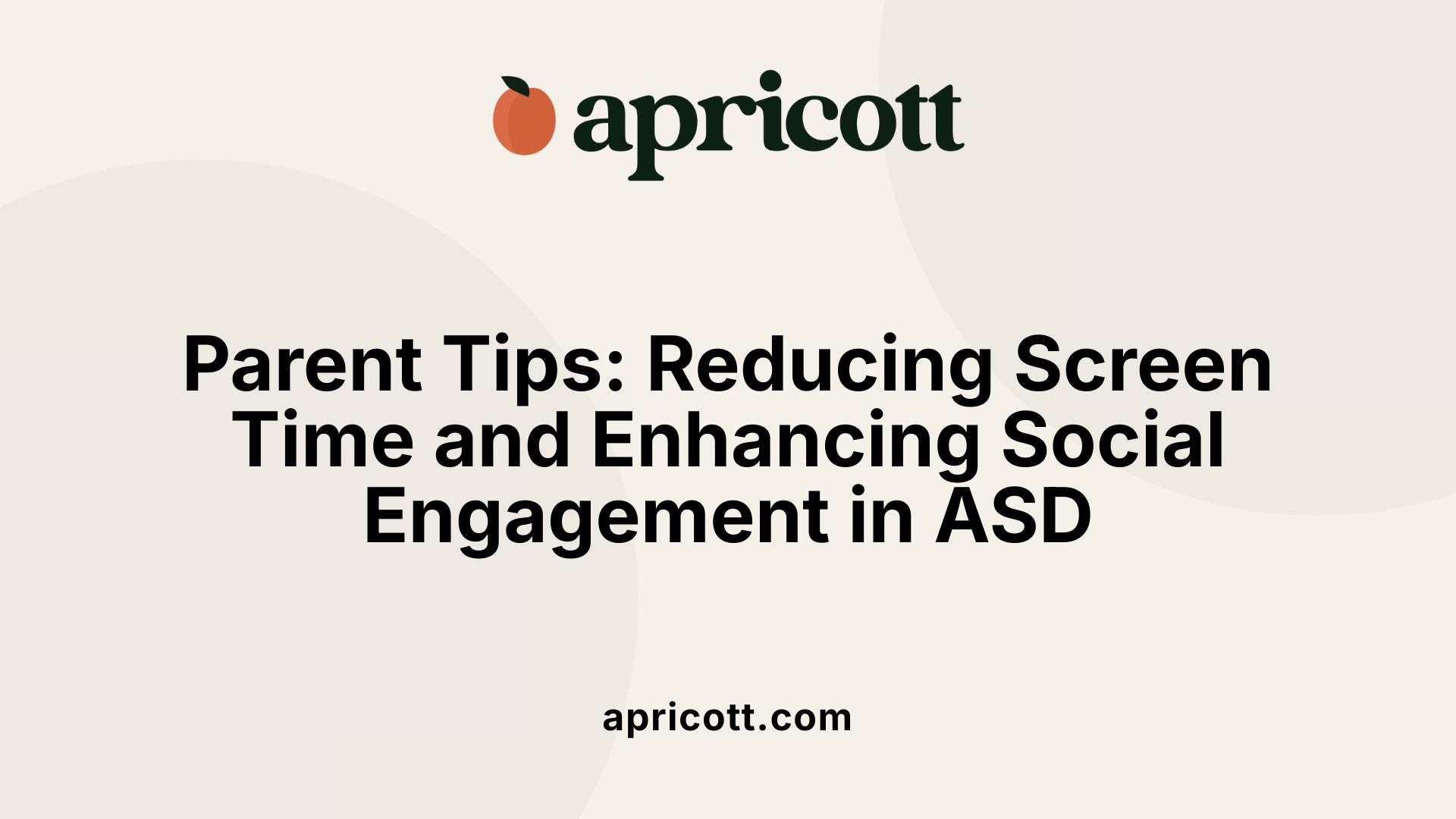
Promoting Early Social Engagement
Encouraging early social interaction is crucial for children with ASD. Activities such as playing, talking, and engaging in joint attention with parents and caregivers can significantly reduce autism symptoms. Replacing screen time with socially oriented experiences fosters eye contact, language development, and peer engagement.
Reducing Screen Time
Minimizing screen exposure is strongly advised, particularly before 18 months of age. The American Academy of Pediatrics suggests no more than one hour of co-viewing daily through age five. Research associates excessive screen use—over four hours daily—with increased autism symptoms and developmental delays. Gradual reductions in screen time can lead to marked improvements in language, behavior, and overall functioning.
Increasing Parent-Child Interaction
Parental involvement during screen use and beyond benefits children with ASD. Currently, only about one-third of children receive parental communication during screen time. Active engagement not only improves development but also reduces parental stress. Structured programs demonstrate how training and home visits support caregivers in promoting meaningful interactions.
Monitoring Device Usage, Especially Before Sleep
Limiting screen exposure before bedtime is important, as screen use can disrupt sleep quality—a factor influencing developmental outcomes. Although approximately half of children with ASD avoid screens before sleep, continued use by others highlights a need for focused guidance on sleep hygiene and screen habits.
Support Resources and Programs
Intervention strategies combining screen time reduction with increased social engagement show promising results, including symptom reduction and better adaptive behaviors. Parent education programs and in-home support can successfully decrease screen use from several hours to mere minutes daily, alleviating parental stress and boosting developmental trajectories.
| Recommendation Area | Specific Actions | Benefits Achieved |
|---|---|---|
| Early Social Engagement | Interactive play, joint attention activities | Reduced autism symptoms, improved social skills |
| Reducing Screen Time | Follow AAP guidelines, gradual screen reduction | Improved language and behavioral outcomes |
| Parent-Child Interaction | Co-viewing, active communication during activities | Decreased parental stress; enhanced child development |
| Device Use Monitoring | Avoid screens before sleep | Better sleep, less behavioral disruption |
| Support Resources | Parent training, in-home visits | Significant symptom reduction, improved caregiver well-being |
Future Directions: Research and Policy to Address Screen Time in Autism Care
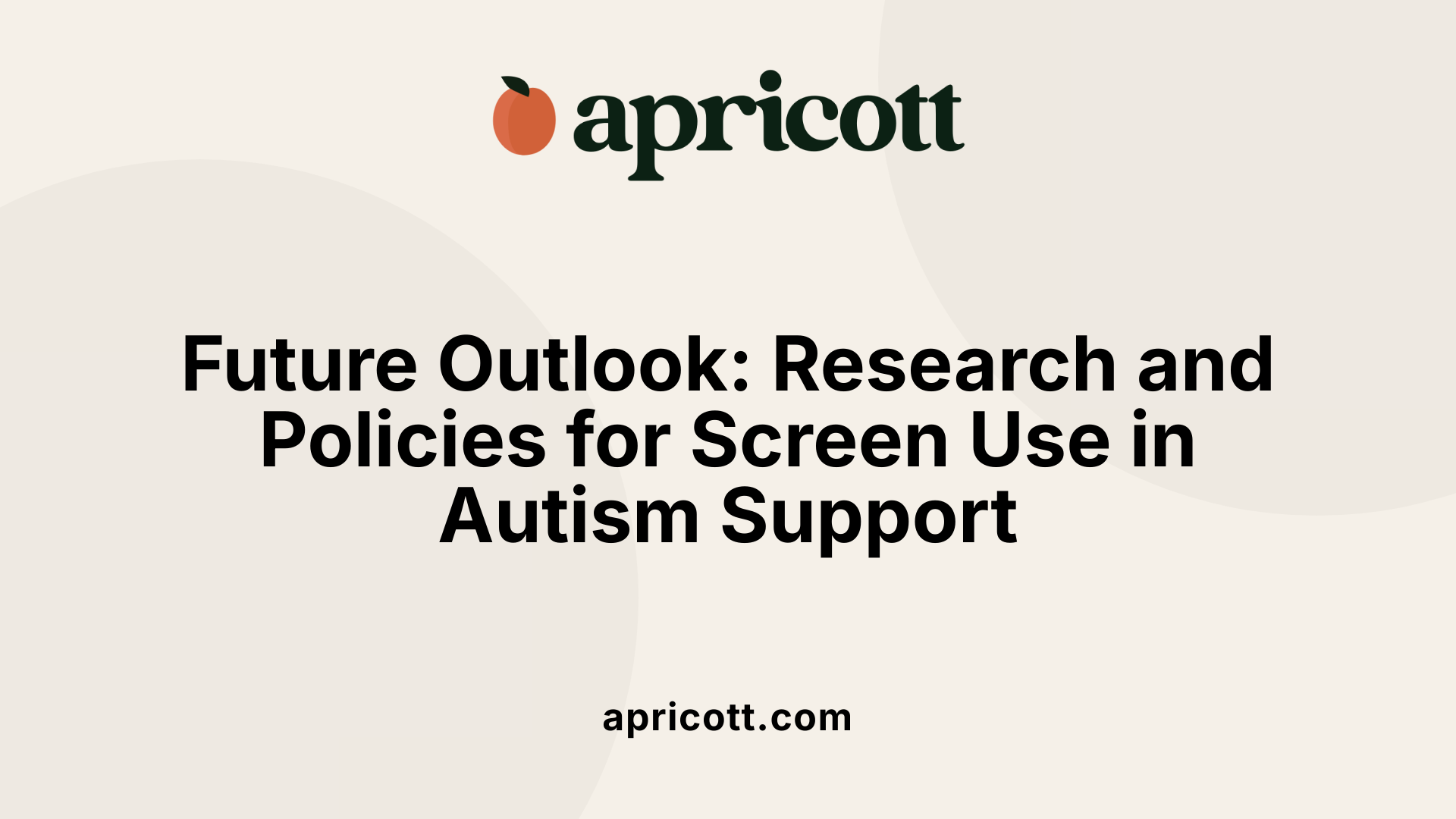
What is the need for further longitudinal studies on screen time in autism care?
Despite growing evidence linking excessive screen time with worsened autism symptoms and developmental delays, there remains a critical need for more longitudinal research. Long-term studies will help clarify how early-life screen exposure influences developmental trajectories over time and identify causal pathways. They will also assess the sustained effects of screen time interventions, providing a stronger evidence base for clinical recommendations.
What policy initiatives are necessary for screen time guidance in children with ASD?
Policy efforts should focus on developing clear, evidence-based screen time guidelines tailored specifically for children with ASD. This includes advocating for adherence to recommendations like those from the American Academy of Pediatrics, emphasizing minimal screen exposure before 18 months and limited co-viewing through age 5. Policies should also encourage resources for families to implement screen time reduction effectively, including access to community programs and parent training.
How can technology use be integrated into autism interventions?
While excessive passive screen time shows negative impacts, thoughtfully designed digital tools hold promise as therapeutic aids. Future directions include creating interactive apps and games that encourage social engagement, language development, and adaptive behaviors. Integrating technology into individualized intervention plans, combined with parental involvement, can harness its benefits while mitigating harm associated with unstructured usage.
Why is advocacy for informed family education important?
Educating families about the risks associated with high screen exposure and the benefits of replacing screen time with social activities is essential. Parent training programs have already demonstrated reductions in core autism symptoms and parental stress by promoting screen time reduction alongside increased social engagement. Broad dissemination of this knowledge empowers families to make informed choices that positively affect children's developmental outcomes.
Collectively, future research and policy must prioritize evidence-based approaches to optimize screen media use in autism care, balancing technological potential with developmental needs.
Balancing Screen Exposure for Positive Autism Outcomes
The growing body of research points to the significant role that screen time plays in the development and manifestation of autism symptoms, particularly in early childhood. Behavioral analysis therapy remains a cornerstone for supporting individuals with autism, and its effectiveness can be amplified by managing environmental factors such as screen exposure. Interventions that reduce screen time in favor of socially oriented activities show promising improvements in language, social interaction, and behavioral outcomes, even demonstrating cases of symptom remission. For parents, caregivers, and professionals alike, understanding and controlling screen exposure is a vital aspect of holistic autism care. Embracing guidelines, empowering families with education and support, and continuing robust research efforts are essential steps toward optimizing developmental trajectories for children with ASD in an increasingly digital world.
References
- Changes in autism symptoms associated with screen ...
- Screen Time and Social Engagement in Early Childhood ...
- Screen time reduction and focus on social engagement in ...
- Screen Time and Autism: Current Situation and Risk ...
- The relationship between screen time and anxiety/depression ...
- Applied Behavior Analysis (ABA)
- Applied Behavior Analysis (ABA)
- Applied Behavior Analysis (ABA)
- Applied Behavior Analysis in Children and Youth with ...
- Applied behavior analysis
.svg)
.svg)








